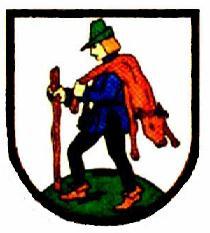Lieberhausen
This page is part of the German heraldry portal Deutsche Wappensammlung |
Heraldry of the World |
|
German heraldry:
|
Selected collector's items from Germany:
|
LIEBERHAUSEN
State : Nordrhein-Westfalen
District (Kreis) : Oberbergischer Kreis
Incorporated into : 1969 Gummersbach
| German | |
| English | No blazon/translation known. Please click here to send your (heraldic !) blazon or translation |
Origin/meaning
The above coat of arms of Lieberhausen has been adopted in 1935.
It is based on a popular folktale about the eponymic ancestor of the inhabitants of the parish of Lieberhausen. He was a poor peasant called Hick, who was compelled to kill his only cow to make a living for his children. As he hoped to get some money for the skin of his cow, he put it on his back and went on his way to Köln to sell it there. The arms show Hick with a stick in his hand and the cowhide on his back. He is depicted, wearing the typical apparel of the countryside: a green hat, black trousers and a blue jerkin.
The story continues as follows :
On his way to Köln Hick picks up a raven and sells it in this town for a high price as a soothsayer to a superstitious innkeeper. Back at Lieberhausen Hick's neighbours are getting jealous of the new-richness. Tired of their impertinence, Hick tells them that he got an enormous amount of money in exchange for his cowhide in Köln. His credulous neighbours do not hesitate one moment to kill all their cows and to follow his example. But to their disappointment they don't even get a fair price for their skins. The angry dupes are now going to kill Hick. They decide to shut him up in a barrel, to transport him to the borders of the river Rhine and to roll the barrel in the waters to drown him. But before getting to work, they take a drink in an inn near the waterside.
Hick in his barrel thinks that his last hour is drawing nearer, but presently he hears a shepherd who is driving his flock by. This gives the shrewd Hick a clue for a possible escape. He starts singing in his barrel that they want to make him bishop in Köln, but he doesn't like it. The amazed shepherd asks Hick why he doesn't accept such an honour. Hick takes up the opportunity and invites the shepherd to change places with him. So the shepherd is drowned in the waters of the Rhine, while Hick is going to drive his flock home.
As his neighbours are coming back to Lieberhausen, mighty proud of their work, they find that their adversary is already there and with a very fine flock of sheep too. The greedy dupes are getting impertinent once again and want to know, where he got his sheep. Hick tells them that he found them on the bottom of the Rhine. Now everybody at Lieberhausen wants to secure himself a great part of the wealth, so they go to the waterside of the Rhine again and there leap into the waters and drown themselves up to the last man and woman. Hick and his family inherit all the possessions of the drowned people and are the ancestors of the future population of Lieberhausen.
Contact and Support
Partners:
Your logo here ?
Contact us
© since 1995, Heraldry of the World, Ralf Hartemink 
Index of the site
Literature: Image and story provided by Robert Czoelner author of (among others) Lieberhäuser Urkundenbuch 1030 - 1945, Gummersbach 1997












